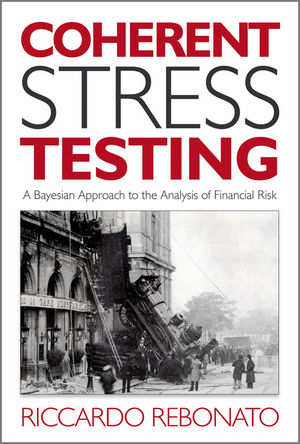Coherent Stress Testing: A Bayesian Approach to the Analysis of Financial StressISBN: 978-0-470-66601-2
Hardcover
240 pages
July 2010
 This is a Print-on-Demand title. It will be printed specifically to fill your order. Please allow an additional 10-15 days delivery time. The book is not returnable.
|
||||||
1 Introduction.
1.1 Why We Need Stress Testing.
1.2 Plan of the Book.
1.3 Suggestions for Further Reading.
I Data, Models and Reality.
2 Risk and Uncertainty – or, Why Stress Testing is Not Enough.
2.1 The Limits of Quantitative Risk Analysis.
2.2 Risk or Uncertainty?
2.3 Suggested Reading.
3 The Role of Models in Risk Management and Stress Testing.
3.1 How Did We Get Here?
3.2 Statement of the Two Theses of this Chapter.
3.3 Defence of the First Thesis (Centrality of Models).
3.3.1 Models as Indispensable Interpretative Tools.
3.3.2 The Plurality-of-Models View.
3.4 Defence of the Second Thesis (Coordination).
3.4.1 Traders as Agents.
3.4.2 Agency Brings About Coordination.
3.4.3 From Coordination to Positive Feedback.
3.5 The Role of Stress and Scenario Analysis.
3.6 Suggestions for Further Reading.
4 What Kind of Probability Do We Need in Risk Management?
4.1 Frequentist versus Subjective Probability.
4.2 Tail Co-dependence.
4.3 From Structural Models to Co-dependence.
4.4 Association or Causation?
4.5 Suggestions for Further Reading.
II The Probabilistic Tools and Concepts.
5 Probability with Boolean Variables I: Marginal and Conditional Probabilities.
5.1 The Set-up and What We are Trying to Achieve.
5.2 (Marginal) Probabilities.
5.3 Deterministic Causal Relationship.
5.4 Conditional Probabilities.
5.5 Time Ordering and Causation.
5.6 An Important Consequence: Bayes’ Theorem.
5.7 Independence.
5.8 Two Worked-Out Examples.
5.8.1 Dangerous Running.
5.8.2 Rare and Even More Dangerous Diseases.
5.9 Marginal and Conditional Probabilities: A Very Important Link.
5.10 Interpreting and Generalizing the Factors x k/i.
5.11 Conditional Probability Maps.
6 Probability with Boolean Variables II: Joint Probabilities.
6.1 Conditioning on More Than One Event.
6.2 Joint Probabilities.
6.3 A Remark on Notation.
6.4 From the Joint to the Marginal and the Conditional Probabilities.
6.5 From the Joint Distribution to Event Correlation.
6.6 From the Conditional and Marginal to the Joint Probabilities?
6.7 Putting Independence to Work.
6.8 Conditional Independence.
6.9 Obtaining Joint Probabilities with Conditional Independence.
6.10 At a Glance.
6.11 Summary.
6.12 Suggestions for Further Reading.
7 Creating Probability Bounds.
7.1 The Lay of the Land.
7.2 Bounds on Joint Probabilities.
7.3 How Tight are these Bounds in Practice?
8 Bayesian Nets I: An Introduction.
8.1 Bayesian Nets: An Informal Definition.
8.2 Defining the Structure of Bayesian Nets.
8.3 More About Conditional Independence.
8.4 What Goes in the Conditional Probability Tables?
8.5 Useful Relationships.
8.6 A Worked-Out Example.
8.7 A Systematic Approach.
8.8 What Can We Do with Bayesian Nets?
8.8.1 Unravelling the Causal Structure.
8.8.2 Estimating the Joint Probabilities.
8.9 Suggestions for Further Reading.
9 Bayesian Nets II: Constructing Probability Tables.
9.1 Statement of the Problem.
9.2 Marginal Probabilities – First Approach.
9.2.1 Starting from a Fixed Probability.
9.2.2 Starting from a Fixed Magnitude of the Move.
9.3 Marginal Probabilities – Second Approach.
9.4 Handling Events of Different Probability.
9.5 Conditional Probabilities: A Reasonable Starting Point.
9.6 Conditional Probabilities: Checks and Constraints.
9.6.1 Necessary Conditions.
9.6.2 Triplet Conditions.
9.6.3 Independence.
9.6.4 Deterministic Causation.
9.6.5 Incompatibility of Events.
9.7 Internal Compatibility of Conditional Probabilities: The Need for a Systematic Approach.
III Applications.
10 Obtaining a Coherent Solution I: Linear Programming.
10.1 Plan of the Work Ahead.
10.2 Coherent Solution with Conditional Probabilities Only.
10.3 The Methodology in Practice: First Pass.
10.4 The CPU Cost of the Approach.
10.5 Illustration of the Linear Programming Technique.
10.6 What Can We Do with this Information?
10.6.1 Extracting Information with Conditional Probabilities Only.
10.6.2 Extracting Information with Conditional and Marginal Probabilities.
11 Obtaining a Coherent Solution II: Bayesian Nets.
11.1 Solution with Marginal and n-conditioned Probabilities.
11.1.1 Generalizing the Results.
11.2 An ‘Automatic’ Prescription to Build Joint Probabilities.
11.3 What Can We Do with this Information?
11.3.1 Risk-Adjusting Returns.
IV Making It Work In Practice.
12 Overcoming Our Cognitive Biases.
12.1 Cognitive Shortcomings and Bounded Rationality.
12.1.1 How Pervasive are Cognitive Shortcomings?
12.1.2 The Social Context.
12.1.3 Adaptiveness.
12.2 Representativeness.
12.3 Quantification of the Representativeness Bias.
12.4 Causal/Diagnostic and Positive/Negative Biases.
12.5 Conclusions.
12.6 Suggestions for Further Reading.
13 Selecting and Combining Stress Scenarios.
13.1 Bottom Up or Top Down?
13.2 Relative Strengths and Weaknesses of the Two Approaches.
13.3 Possible Approaches to a Top-Down Analysis.
13.4 Sanity Checks.
13.5 How to Combine Stresses – Handling the Dimensionality Curse.
13.6 Combining the Macro and Bottom-Up Approaches.
14 Governance.
14.1 The Institutional Aspects of Stress Testing.
14.1.1 Transparency and Ease of Use.
14.1.2 Challenge by Non-specialists.
14.1.3 Checks for Completeness.
14.1.4 Interactions among Different Specialists.
14.1.5 Auditability of the Process and of the Results.
14.2 Lines of Criticism.
14.2.1 The Role of Subjective Inputs.
14.2.2 The Complexity of the Stress-testing Process.
Appendix A Simple Introduction to Linear Programming.
A.1 Plan of the Appendix.
A.2 Linear Programming – A Refresher.
A.3 The Simplex Method.
References.
Index.



